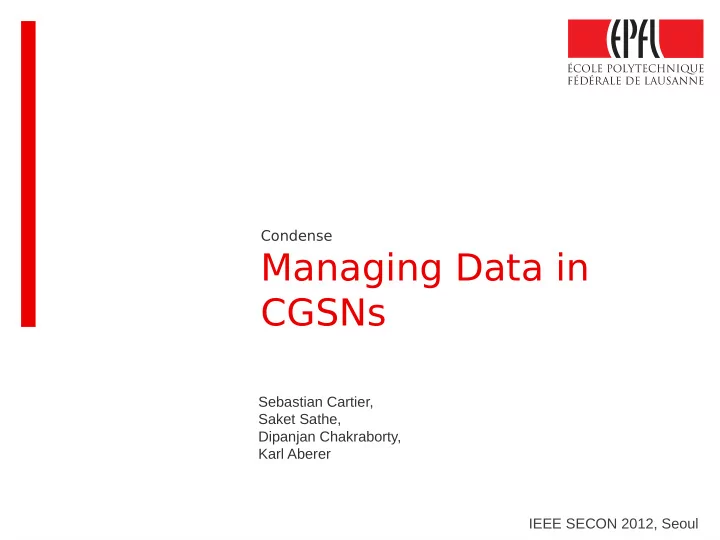

Condense Managing Data in CGSNs Sebastian Cartier, Saket Sathe, Dipanjan Chakraborty, Karl Aberer IEEE SECON 2012, Seoul
Content 1.CGSNs 2.Condense 3.Model Cover Estimation 4.Adaptive Methods 5.Datasets 6.Experiments IEEE SECON 2012, Seoul
Motivation Community-driven Mobile Geo-Sensor Network Community-driven No central authority Different sensor quality Different update rate Unreliable readings Uncontrollable movement of sensor nodes Irregular Data Daytime, Season Geographic situation Sensed Values Pollution, T emperature, Radiation Challenge: Produce homogenous view on this data IEEE SECON 2012, Seoul
Condense Sensor Layer Deployment by data distributor Sensor readings are continuously updated in Database Each reading is represented in a tuple: Timestamp Position Reading value IEEE SECON 2012, Seoul
Condense Model Layer Abstraction level for raw data Model cover More than one model Single models are less complex Continuous update of models Model layer is main focus of this Project IEEE SECON 2012, Seoul
Condense Query Layer No direct access to raw data One ore more model responsible for each query position Possible queries: Single position Continuous queries Moving continuous queries IEEE SECON 2012, Seoul
Problem Characterization Model Cover Estimation One mathematical Model is not enough! Given: Region of interest R and raw tuples of one time window W s Partition of region R: R 1 ,R 2 ,…R p Raw tuples are distributed among regions For each Region R α we want to create a Model M α IEEE SECON 2012, Seoul
Problem Characterization Model Cover Maintenance New points are streamed into the system: W s+1 Which models have to be updated Only update these Models The other models are still valid from last time window Reduce cost by adapting the model cover, instead of creating new model cover for each new time window
Adaptive K-Means Adaptive Method 1. Select 2 region centers 2. Run Simple K-Means R 3. Check for each region if error criteria is met Easting IEEE SECON 2012, Seoul
Adaptive K-Means Adaptive Method 1. Select 2 region centers 2. Run Simple K-Means R 3. Check for each region if error criteria is met 4. For each region, where error is too high: 1. Select reading with highest error Easting 2. Create new region center 5. Jump to step 2, if new regions were created IEEE SECON 2012, Seoul
Datasets Records Interval Pollutant Mounted on Cabspotting 11 m 50 sec - Taxicab Opensense Zurich 110 k 40 sec Ozone Public tram Opensense Lausanne 70 k 60 sec Ozone Public bus Safecast 970 k 5 sec radiation Car Cabspotting: only positioning data Zurich and Lausanne: clean environment Safecast: radiation is changing slowly and predictable in time IEEE SECON 2012, Seoul
Experiments Error Analysis Opensense Zurich H = 6 hours, P = 50 Random time windows Plot normal percentage error Observations No significant difference with Opensense Safecast DBSCAN: Number of Regions p is not controllable IEEE SECON 2012, Seoul
Experiments Time Efficiency Model cover creation time Opensense Lausanne Start time of time window is constant Normal Percentage error is constant Increase of H number of raw tuples Observations Query time Complex methods are slow Grid based modeling is the fastest IEEE SECON 2012, Seoul
Experiments Model Cover Maintenance Adaptive K-Means Training period of 6 hours H = 30 minutes, W 0 ,W 1 ,…,W 88 streamed into Condense Updating only region with high normal percentage error Flops: rough estimate of update cost Grid-based model cover Observations Adaptive K-Means is able to adapt to data IEEE SECON 2012, Seoul
Recommend
More recommend